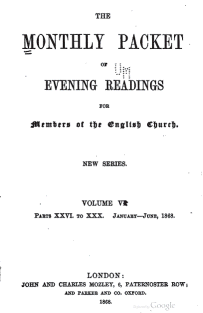The Monthly Packet of Evening Readings for Younger Members of the Church of England was a magazine targeted at girls aged between 15 and 25, “young girls, or maidens or young women, whichever you like to be called”. Published from 1851 until 1899, its aim was to help its readers incorporate religion into their daily lives,[1] following an extended period of turmoil in the Church of England.[2]
The Oxford Movement in particular, members of which were known as Tractarians,[a]Members of the Oxford Movement had put forward a series of 90 tracts, giving them their name.[3] had put forward the view that Anglicanism was merely one branch of the Christian church, and many members of the clergy – notably John Henry Newman – had converted to Catholicism, which they saw as more compatible with the older traditions of faith. Even the most conservative of churchmen were forced to accept that the Church of England had become just one denomination among many, and that “religious behaviour was becoming, by definition, voluntary behaviour”.[2]
The magazine was the inspiration of Mary Anne Dyson and her brother the Reverend Charles Dyson, who intended it as an alternative to the increasingly politicised Churchman’s Companion. Charlotte Yonge, an already established English novelist and long-standing friend, became the magazine’s first editor,[4] a position she held until 1894 when she was replaced by Christabel Coleridge, in an effort to make the magazine more relevant to its fin de siècle audience and distance itself from its perceived mid-Victorian view of the world.[5]
Format and publication history
Early issues of The Monthly Packet, initially priced at 6d,[b]2½p in decimal currency. were 64 pages long, but by 1860 it had increased to 112 pages. The magazine never contained illustrations, marking it out as more of a book than the later illustrated girl’s periodicals, and it often contained poetry – usually of a religious nature – as well as stories and articles.[5]
The print run was divided into four series, the first from 1851 to 1865. In 1866 the title was changed to remove the word Younger, and that second series continued until 1880. The third series was published from 1881 until 1890, and the fourth from 1891 until the magazine’s demise in 1899.[6]
Contributions
The first issue of The Monthly Packet was written almost entirely by Charlotte Tonge herself, but over time she carefully recruited other contributors able to produce work she considered suitable. Charlotte’s evident policy was to encourage and foster the careers of young women writers, and indeed most of her contributors were women,[7] including Rosa Nouchette Carey, whose serialisation of her novel Heriot’s Choice appeared in 1879.[8]
The magazine was the first periodical to publish Lewis Carroll’s short stories, from April 1880 until May 1885, later compiled into A Tangled Tale (1885).[9]

